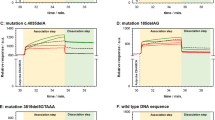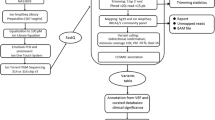Abstract
BRCA1 mutations are associated with a higher risk of breast (BC) and ovarian cancer in women. Testing for such mutations allows BC prognosis, selection of an individual treatment strategy, and prevention of disease recurrence. Hybridization on a hydrogel microarray was developed for identifying point mutations in BRCA1. The microarray was designed to detect five-point mutations: 185delAG, 300T→G, 4153delA, 4158A→G, and 5382insC. The microarray was tested with 36 control specimens with known genotypes and used to examine 65 BC patients. The results demonstrated the advantage of employing the microarray in analyzing BRCA1 mutations.
Similar content being viewed by others
References
Trapeznikov N.N., Aksel’ E.M. 2000. In: Zabolevaemost’ zlokachestvennymi novoobrazovaniyami i smertnost’ ot nikh naseleniya stran SNG v 1998 (Morbidity and Mortality Caused by Malignant Tumors in CIS Countries in 1998). Moscow: Onkol. Nauchn. Tsentr Ross. Akad. Med. Nauk.
Miki Y., Swensen J., Shattuck-Eidens D., et al. 1994. A strong candidate for the breast and ovarian cancer susceptibility gene BRCA1. Science. 266, 66–71.
Wooster R., Bignell G., Lancaster J., et al. 1995. Identification of the breast cancer susceptibility gene BRCA2. Nature. 378, 789–792.
Ford D., Easton D.F., Bishop D.T., et al. 1994. Risks of cancer in BRCA1-mutation carriers. Breast Cancer Linkage Consortium. Lancet. 343, 692–695.
Easton D.F., Ford D., Bishop D.T. 1995. Breast and ovarian cancer incidence in BRCA1-mutation carriers. Am. J. Hum. Genet. 56, 265–271.
Roa B.B., Boyd A.A., Volcik K., Richards C.S. 1996. Ashkenazi Jewish population frequencies for common mutations in BRCA1 and BRCA2. Nature Genet. 14, 185–187.
Janiszewska H., Haus O., Lauda-Swieciak A., et al. 2003. Frequency of three BRCA1 gene founder mutations in breast/ovarian cancer families from the Pomerania-Kujawy region of Poland. Clin. Genet. 64, 502–508.
Perkowska M., BroZek I., Wysocka B., et al. 2003. BRCA1 and BRCA2 mutation analysis in breast-ovarian cancer families from northeastern Poland. Hum. Mutat. 21, 553–554.
Csokay B., Tihomirova L., Stengrevics A., Sinicka O., Olah E. 1999. Strong founder effects in BRCA1 mutation carrier breast cancer patients from Latvia. Mutation in brief no. 258. Online. Hum. Mutat. 14, 92.
Gayther S.A., Harrington P., Russell P., Kharkevich G., Garkavtseva R.F., Ponder BA. 1997. Frequently occurring germ-line mutations of the BRCA1 gene in ovarian cancer families from Russia. Am. J. Hum. Genet. 60, 1239–1242.
Karpukhin A.V., Pospekhova N.I., Lyubchenko L.N., Loginova A.N., Khomich E.V., Budilov A.V., Sergeev A.S., Zakhar’ev V.M., Gar’kavtseva R.F., Ginter E.K. 2002. Frequencies of oligonucleotide polymorphisms and mutations in the ARNA1 gene in hereditary breast and ovarian cancer. Dokl. Akad. Nauk. 383, 706–709.
Tillib S.V., Strizhkov B.N., Mirzabekov A.D. 2001. Integration of multiple PCR amplifications and DNA mutation analyses by using oligonucleotide microchip. Anal. Biochem. 292, 155–160.
Gorbunova V.N., Baranov V.S. 1997. Vvedenie v molekulyarnuyu diagnostiku i genoterapiyu nasledstvennykh zabolevanii (Introduction to Molecular Diagnosis and Gene Therapy of Hereditary Diseases). St. Petersburg: Spetsial’naya Literatura.
Rubina A.Yu., Pan’kov S.V., Dementieva E.I., Pen’kov D.N., Butygin A.V., Vasiliskov V.A., Chudinov A.V., Mikheikin A.L., Mikhailovich V.M., Mirzabekov A.D. 2004. Hydrogel drop microchips with immobilized DNA: properties and methods for large-scale production. Anal. Biochem. 325, 92–106.
Glotov A.S., Nasedkina T.V., Ivashchenko T.E., Baranov V.S., Yurasov R.A., Surzhikov S.A., Pan’kov S.V., Chudinov A.V., Baranov V.S., Zasedatelev A.S. 2005. Development of a biochip for analyzing polymorphism of the biotransformation genes. Mol. Biol. 39, 1–10.
Marcus J.N., Watson P., Page D.L., Narod S.A., Lenoir G.M., Tonin P., Linder-Stephenson L., Salerno G., Conway T.A., Lynch H.T. 1996. Hereditary breast cancer: pathobiology, prognosis, and BRCA1 and BRCA2 gene linkage. Cancer. 77, 697–709.
Meijers-Heijboer H., Brekelmans C.T., Menke-Pluymers M. 2003. Use of genetic testing and prophylactic mastectomy and oophorectomy in women with breast or ovarian cancer from families with a BRCA1 or BRCA2 mutation. J. Clin. Oncol. 21, 1675–1681.
Narod S.A. 2002. Modifiers of risk of hereditary breast and ovarian cancer. Nature Rev. Cancer. 2, 113–123.
Metcalfe K.A., Lynch H.T., Ghadirian P., Tung N., Olivotto I.A., Foulkes W.D., Warner E., Olopade O., Eisen A., Wever B., McLennan J., Sun P., Narod S.A. 2005. The risk of ovarian cancer after breast cancer in BRCA1 and BRCA2 carriers. Obstet. Gynecol. Surv. 60, 235–236.
Orban T.I., Csokay B., Olah E. 2000. Sequence alterations can mask each other’s presence during screening with SSCP or heteroduplex analysis: BRCA genes as examples. Biotechniques. 29, 94–98.
Abbaszadegan M.R., Struewing J.P., Brown K.M., Snider J.V., Goodsaid F., Gore-Langton R., Hughes M.R. 1997–1998. Automated detection of prevalent mutations in BRCA1 and BRCA2 genes, using a fluorogenic PCR allelic discrimination assay. Genet. Test. 1, 171–180.
Grudinina N.A., Golubkov V.I., Tikhomirova O.S., Brezhneva T.V., Khanson K.P., Vasil’ev V.B., Mandel’shtam M.Yu. 2005. Prevalence of widespread mutations in the BRCA1 gene in patients with familial ovarian cancer in St. Petersburg. Genetika. 41, 405–410.
Author information
Authors and Affiliations
Additional information
Original Russian Text © O.E. Fedorova, O.N. Sinicka, L.P. Tihomirova, Ya.V. Visnevskaya, A.S. Zasedatelev, T.V. Nasedkina, 2006, published in Molekulyarnaya Biologiya, 2006, Vol. 40, No. 1, pp. 31–36.
Rights and permissions
About this article
Cite this article
Fedorova, O.E., Sinicka, O.N., Tihomirova, L.P. et al. Analysis of point mutations of the BRCA1 gene by hybridization with hydrogel microarrays. Mol Biol 40, 25–29 (2006). https://doi.org/10.1134/S0026893306010055
Received:
Issue Date:
DOI: https://doi.org/10.1134/S0026893306010055




